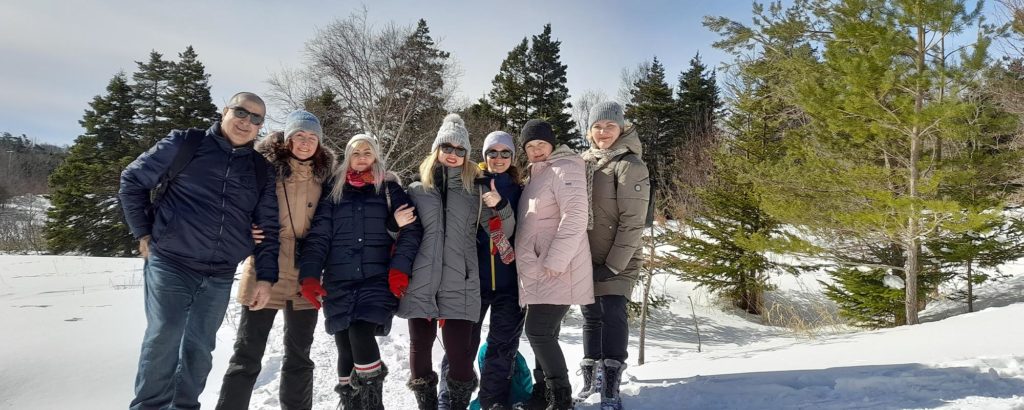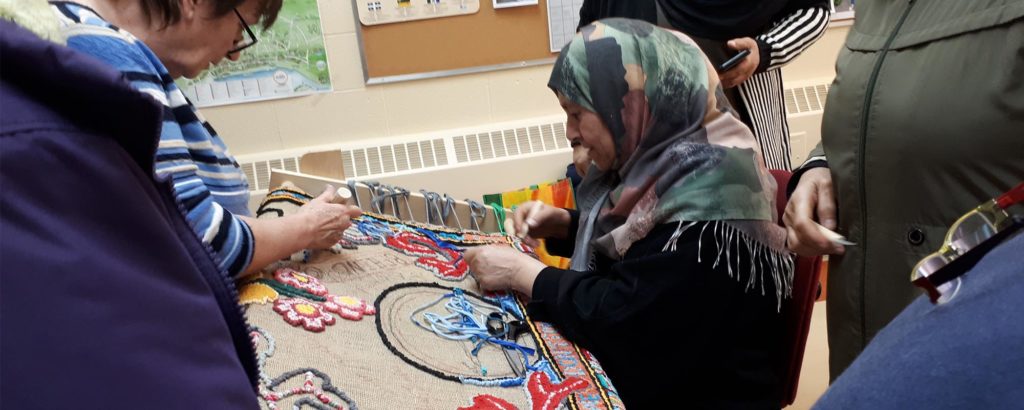Why Come to Canada
Canada and the people of Newfoundland and Labrador welcome you. We are happy you decided to make your new home here.
Canada is the second-largest country in the world and has a population of more than 35 million people. It is divided into ten provinces and three territories and surrounded by three oceans – Atlantic in the east, Pacific in the west and Arctic to the north.

Human Rights in Canada
In Canada, an individual’s human rights are protected by the Constitution, as well as federal, provincial and territorial laws.
Canada’s human rights laws often reflect international human rights instruments such as the Universal Declaration of Human Rights. In 1948, the international community came together to make sure that human rights laws were written and understood.
When it was complete, the Declaration provided a list of 30 articles outlining everyone’s universal human rights.
Since the Canadian Charter of Rights and Freedoms came into effect in 1982, it has confirmed and strengthened Canada’s values.
Canadian History
The name “Canada” likely comes from the Huron-Iroquois word “kanata,” meaning “village” or “settlement.”
Before the arrival of Europeans, North America was inhabited by Indigenous people living and thriving within their own distinct cultures, languages, and ways of knowing. Indigenous Peoples have lived in what is now called Canada for over 10,000 years.
The historical relationship between Indigenous peoples and non-Indigenous peoples of Canada is complex and influenced by colonialization, historical events, laws and racist attitudes.
These events have shaped contemporary issues still felt today by Indigenous peoples. However, there are various initiatives currently underway in Canada to improve and address the historic wrongs of the past.
With the focus on the protection of human rights increasing around the world, we’re learning more about the many indigenous territories throughout Canada using native-land.ca, including the Beothuk, and the island of Newfoundland as the ancestral homelands of the Mi’kmaq and Beothuk.
The ANC would also like to recognize the Inuit of Nunatsiavut and NunatuKavut and the Innu of Nitassinan, and their ancestors, as the original people of Labrador.
On June 21 2021, changes to Canada’s Oath of Citizenship became law and addressed the Truth and Reconciliation Commission’s Call to Action 94.
The new Oath refers to the Aboriginal and treaty rights of First Nations, Inuit and Métis peoples. With the changes to the Oath, new Canadians will acknowledge the importance of Indigenous and treaty rights in Canada:
“I swear (or affirm) that I will be faithful and bear true allegiance to Her Majesty Queen Elizabeth the Second, Queen of Canada, Her Heirs and Successors, and that I will faithfully observe the laws of Canada, including the Constitution, which recognizes and affirms the Aboriginal and treaty rights of First Nations, Inuit and Métis peoples, and fulfil my duties as a Canadian citizen.”
Related Resources
- Truth and Reconciliation Commission
- Orange Shirt Day
- The United Nations Declaration on the Rights of Indigenous Peoples
- Missing and Murdered Indigenous Women and Girls

Welcome to Newfoundland and Labrador
Newfoundland and Labrador (NL) is one of the four provinces of Atlantic Canada, along with New Brunswick, Nova Scotia, and Prince Edward Island (PEI). Newfoundland and Labrador is the easternmost province of Canada.
The tenth province to join Canada, the province includes the island of Newfoundland and the mainland portion of Labrador, which is located across the Strait of Belle Isle on the mainland of North America. The entire province was known as Newfoundland when it became part of Canada in 1949. In 2001, the province became officially known as “Newfoundland and Labrador.”
Newfoundland and Labrador’s capital and largest city, St. John’s, is Canada’s 20th-largest census metropolitan area and is home to almost 40 percent of the province’s population. The city is home to the province’s seat of Government, the House of Assembly, and its highest provincial court, the Newfoundland and Labrador Court of Appeal.
History
Newfoundland and Labrador have very distinct, but rich, diverse, and ancient histories. People have made this region their home for around 9,000 years; the earliest cultures to settle here were the Maritime Archaic Peoples, about whom not much is directly known, as there are no written records which are known to exist. The Dorset of the Groswater Culture gradually populated what would become Newfoundland and Labrador during the Iron Age. The Indigenous Nations which populated this region prior to and following contact with European settlers are: the Mi’Kmaq, the Innu, and the Inuit of Labrador, who currently make up the totality of Indigenous groups in the province. The Beothuk became extinct following contact with European Colonizers, with whom there were regular acts of violent conflict, along with the transmission of disease to these Indigenous Peoples who lacked immunity.
Newfoundland (Taqamkuk in the Mi’kmaq language) is the site of the only authenticated Norse settlement in North America. Research has revealed that the settlement dates to about the year 1000, and the site contains the earliest-known European structures in North America. About 500 years later, in 1497, the Italian navigator Giovanni Caboto became the first European since the Norse settlers to explore Newfoundland, commissioned by King Henry VII of England, landing in Bonavista. In 1583, Sir Humphrey Gilbert formally claimed Newfoundland as a colony of England. In 1610, John Guy developed the earliest modern European settlement in Newfoundland at Cupids.
The origin of Labrador’s name has been popularly ascribed to Portuguese explorer João Fernandes Lavrador who was granted a patent by King Manuel I of Portugal in 1499 that gave him the right to explore that part of the Atlantic Ocean. Previously Labrador was called Nitassinan which means “our land”; in the Innu language. Additionally, the area was known as Markland in Greenlandic Norse and its inhabitants were known as the Skræling.
Geography
Here are some geographical facts about the Newfoundland and Labrador:
- Newfoundland and Labrador is the easternmost province in Canada. The Strait of Belle Isle separates the province into two geographical divisions, Labrador and the island of Newfoundland. The province also includes over seven thousand small islands.
- Newfoundland and its neighbouring small islands have an area of 111,390 km² (43,010 sq mi).Labrador’s area (including associated small islands) is 294,330 km² (113,640 sq mi). Together, Newfoundland and Labrador comprise 4.06% of Canada’s area.
- Newfoundland is located in a unique time zone in North America. It is a half an hour ahead of Atlantic Time. Labrador operates on Atlantic Time, except for the coast between L’Anse au Clair and Norman’s Bay, which is on Newfoundland time.

Climate
Newfoundland and Labrador has four seasons: spring, summer, winter, and fall. Spring usually arrives late and is quite cool. Summers are usually pleasant, not too hot, nor too cold. Even though the seawater is relatively cool, and the temperature rarely goes over 20°C, Fall generally is cool, with mixtures of sun, and rain. Winters are usually long and cold, with lots of snow — from November to April. Winter storms sometimes cause school and business closures. It is very windy in the Province. The wind makes cold temperatures seem colder, but during the summer it gives some relief from the heat.
- Average Spring temperatures range from -10°C in Northern Labrador to 6°C in Southern Newfoundland.
- Average Summer temperatures range from 5 to 10°C in Northern Labrador to 16°C in Southern Newfoundland.
- Fall temperatures range from -4°C in Northern Labrador to 11°C in Southern Newfoundland.
- Winters temperatures range from -26°C in Northern Labrador to -7°C in Southern Newfoundland.
- The island receives an average yearly rainfall of 1,191 mm and an average yearly snowfall of 322 cm.
Population
Here are some population facts:
- The population of NL is estimated to be 520,438 as of 2021.
- About 92% of the province’s population lives on the island of Newfoundland.
- More than 50% of the population lives on the Avalon Peninsula.
- 97% speak English as their primary language.
- 8.9% of population identify as Indigenous.

Communities
Newfoundland and Labrador’s capital and largest city, St. John’s, is Canada’s 20th-largest census metropolitan area and is home to almost 40 percent of the province’s population.
Newfoundland has two other official cities: Mount Pearl, which is located directly south west of St. John’s, and Corner Brook, which is the largest regional centre for the western portion of Newfoundland. As well, there are 276 officially incorporated
communities and 177 unincorporated Local Service Districts scattered across the province.
Government
- NL has 40 elected representatives called Members of the House of Assembly (MHAs). They are responsible for making the laws in Newfoundland and Labrador.
- The head of government in NL is a Premier. The current Premier is the Honourable Andrew Furey.
- The Province has a Lieutenant Governor, who is appointed as the Queen’s provincial representative. The current Lieutenant Governor is the Honourable Judy Foote.
- NL has seven elected Members of Parliament (MPs) who represent their district in the Canadian House of Commons in Ottawa.
Economy
- The major industries in the province are natural resources, service, agriculture, and tourism.
- Oil production contributed $6.7 billion to nominal GDP in 2019 and represented 1.9% of total employment in the province.
- Mineral shipments from Newfoundland and Labrador were valued at $4.4 billion in 2020.
- Manufacturing industry contributed an estimated $1.0 billion to nominal GDP, representing 3.0% of total provincial GDP.
- As of 2020, the fish and seafood sector employs approximately 15,800 persons from over 400 communities in the province.
- Provincial agriculture contributed $129.9 million in 2020.
Related Resources
- Government of NL
- NL House of Assembly
- Office of Immigration and Multiculturalism
- NL English School System
- NL French School System
We have made every effort to ensure that the information in this Guide is accurate and up-to-date. If you find any errors or omissions, please contact us.